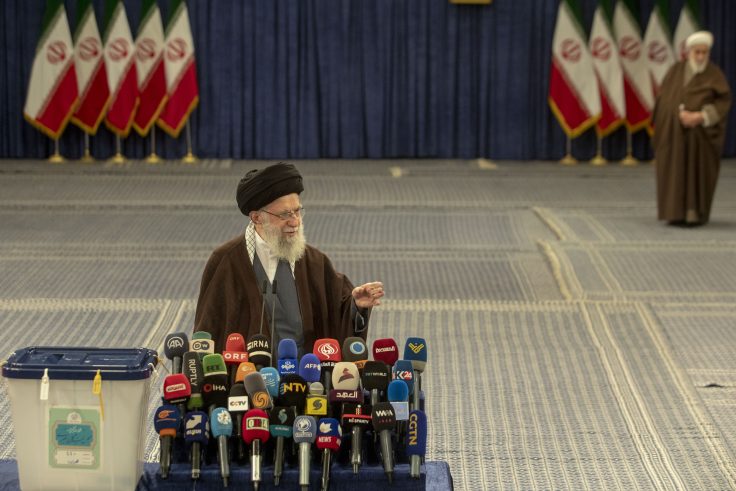Iran could rush to build a functional nuclear weapon ahead of the 2024 presidential election should it assess that Donald Trump is poised to win, U.S. foreign policy experts are warning as Tehran works to undermine Trump's White House bid.
"Iran may seek to establish a nuclear fait accompli before the next administration takes office in January 2025, especially if Iran perceives the new administration to be more hawkish, unpredictable, or otherwise less constrained," the Foundation for Defense of Democracies think tank wrote in a recent assessment detailing Tehran’s march towards an atomic bomb.
That assessment comes as Iran seeks to influence the outcome of the November election, including by targeting the Trump campaign with a cyber operation. The campaign announced an Iranian hack in August when stolen materials were sent to news outlets such as the New York Times and Washington Post.
U.S. intelligence officials have signaled that Tehran opposes Trump's bid to return to the White House, as it did in 2020. Democratic nominee Kamala Harris opposed Trump’s decision to pull out of the 2015 nuclear deal, and political pundits expect her to pursue fresh diplomacy with Iran.
Regional analysts tracking the situation say that Iran is already in "the process of significantly advancing its nuclear weapons program in the coming weeks while Americans are preoccupied with politics at home and Israel is busy battling Hamas and Hezbollah." Iran has been furiously enriching uranium, the key fuel for a bomb, at several contested military sites hidden from international inspectors.
Iran is already on the "threshold" of a nuclear bomb, needing just a week to fuel its first warhead and a month for seven more—work that already has regional analysts warning that the Middle East is on the cusp of a "nuclear Oct. 7th."
Iran currently has the technical ability and resources needed to fuel 13 nuclear bombs in just four months, a significant acceleration that has taken place primarily under the Biden-Harris administration.
Secretary of State Antony Blinken has assessed that Iran is "one or two weeks" away from producing weapons-grade uranium, making this "the shortest period of time that U.S. officials have ever publicly referenced Iran producing that quantity of weapons-grade uranium," according to FDD’s analysis.
By contrast, just before Trump left office in November 2020, Iran needed around three-and-a-half months to produce the fuel for a single weapon. Presently, Iran could fuel 12 weapons within this same time frame.
Iran’s nuclear work went into overdrive after the Biden-Harris administration began relaxing sanctions on the hardline regime and renewed diplomatic efforts to ink a revamped version of the 2015 nuclear accord. Tehran has received upwards of $100 billion in sanctions relief over the past several years, with these funds helping to power its advancements toward a nuclear bomb.
"Compared to Iran's relative nuclear restraint under the Trump administration's maximum pressure policy, the regime has advanced its nuclear activities dramatically during Biden's term in office as the administration pursued a policy of engagement, diplomacy, and sanctions relief," said Andrea Stricker, a veteran nonproliferation expert and FDD research fellow. "Despite Trump exiting the Iran deal in 2018, Tehran was restrained in its nuclear advances, suggesting it was deterred from making large leaps forward by a credible military threat and economic sanctions."
"Biden-Harris's policies," she said, "have clearly been a failure but, against all evidence, the administration refuses to change course."
As the U.S. administration pushed for a diplomatic detente, Tehran’s hardline regime took the unprecedented step of producing even more highly enriched uranium that is on standby if it decides to build a bomb.
Iran now has more than 6,200 kilograms of uranium enriched to 5, 20, and 60 percent purity levels, which puts it a stone’s throw away from the 90 percent "weapons-grade" threshold. During Trump’s term in office, Iran produced less than 2,400 kilograms of low-enriched uranium.
Along with its uranium stockpiles, Tehran’s technical ability to enrich uranium has grown under the Biden-Harris administration.
The country installed "thousands of fast-operating advanced centrifuges to enrich uranium" and now maintains more than 7,400 advanced centrifuges that rapidly enrich uranium to the levels needed for a bomb, according to Stricker and David Albright, who runs the Institute for Science and International Security, a nuclear watchdog group.
Iran has also reactivated work at the Fordow enrichment plant, a long-contested military site built into the side of a mountain. At this location, Tehran is installing "even more advanced centrifuges" that will enable it to more rapidly produce weapons-grade uranium, according to Stricker.
Another new "deeply buried" site is currently being built near Iran’s Natanz enrichment facility and likely would be immune to any offensive strike by the United States or Israel.
Tehran’s nuclear advancements have given it the luxury of carrying out much of this work behind closed doors, away from the international community’s oversight. United Nations inspectors are barred from visiting several of Iran’s military sites, and a great deal of nuclear work can now be conducted using computer models.
This raises the possibility that Tehran may have "a clandestine weaponization program that is escaping detection by Western intelligence agencies," according to Stricker, who said the country would only need to divert its enriched uranium to a secret site where further enrichment and weapons work is taking place. "Once the material is diverted to underground sites, it would be difficult for foreign powers to disrupt a breakout."
